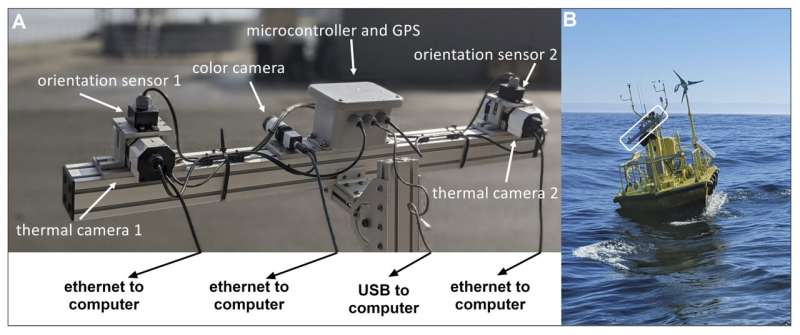UK
Academic calls for upgrade to sewage systems to protect health

The risk to public health from human feces in our rivers and seas will increase without action to create a wastewater system fit for the future, according to a Leeds academic.
Professor Barbara Evans, Leeds' Professor of Public Health Engineering, has collaborated on a new report which assesses the best ways to reduce dangers associated with recreational use of water contaminated by sewage.
She said, "Investments in sanitation require national vision and leadership; 150 years ago, the U.K. committed to eliminating cholera and made the necessary huge investments in our wastewater system; we have reaped the benefit of that vision for our whole lives, and we probably haven't been sufficiently aware of it.
"That investment is reaching the end of its life, and we owe it to our children and our grandchildren to make a new commitment and create a vision of a new wastewater system fit for the future."
The report, led by the Royal Academy of Engineering, calls for improvements to the country's sewage system, better maintenance, and more widespread testing of the country's waterways to reduce the risks to swimmers and other water users.
Professor Evans, from Leeds' School of Civil Engineering, was a member of the working group that led the project.
She said, "It's important that people use our natural resources for leisure. It's good for public health and we don't want to stop that.
"What we want to do is to find interventions that bring down the risk of the chance of disease outbreaks when people use those resources."
Reducing people's risk of encountering human fecal pathogens in untreated and treated sewage discharged into rivers and coastal waters must be a priority, the document said.
Consumption of water contaminated with human feces exposes people to bacteria such as salmonella and E. coli, viruses and protozoa, all of which can cause stomach upsets, diarrhea and vomiting. Small children are particularly vulnerable.
The report says collective action by industry, government, public bodies and the general public is required. It makes 15 recommendations, including: review current bathing water regulations; prioritize maintenance of the existing sewage network; return to collecting widespread data on fecal bacteria; develop a long-term strategy for better designing cities to reduce flooding, and the appointment of a dedicated wastewater champion.
Professor Chris Whitty, England's chief medical officer, said it was a "public health priority as well as an environmental one."
First of its kind
This is the first time a comprehensive report has been undertaken to assess actions to reduce public health risks associated with use of public waters contaminated by fecal matter from human waste.
Its findings are based on risk-based assessments and consultations with more than 100 engineers, plus wastewater experts, the water industry, campaign organizations and policymakers.
Despite wastewater treatment works reducing the concentration of human fecal organisms, the continuous discharge of treated effluent into rivers, seas and lakes remains a source of these potentially health-damaging organisms.
The report's authors emphasize that the aim is not to completely remove all those organisms but to find cost-effective, long-term methods of reducing them to a level that does not put public health in jeopardy.
Greater exposure to pollutants
The report, published on 21 May by the National Engineering Policy Center, notes the rise in recreational activities in coastal and inland open waters across the U.K., leading to greater public exposure to pollutants. Increased public awareness and data availability on water quality have spurred renewed scrutiny over U.K. water standards and necessitated a revaluation of the public acceptability of the risk.
The report notes that there is a lack of evidence to demonstrate a direct, causal link between specific wastewater discharges and specific health incidents but emphasizes the known public health risk from exposure to high concentrations of fecal organisms.
It focuses on the role of wastewater infrastructure in introducing primarily human fecal organisms into open water through storm overflows and treated effluent discharge. It does not look at agricultural runoff from livestock, wild animals, or septic tanks.
The working group examined a range of actions across storm water management, wastewater treatment, monitoring and communication with the public, and maintenance and operations. The proposed actions aim to either engineer a reduction in the hazard itself or minimize public exposure to it and the report emphasizes that the choice of action will depend on local conditions, including scale, geography, policy priorities and affordability.
The authors said that the government should not just focus on improving infrastructure—which would reduce the short-term health risk—but a longer-term vision for how the U.K.'s cities are designed.
Public health priority
Professor Whitty said, "Public waterways are a great resource enjoyed by many children and adults and can have a significant positive impact on our health.
"Minimizing human fecal organisms in fresh water is a public health priority as well as an environmental one.
"While there will always be challenges with the efficient management of sewers and sewage treatment works, this report provides clear technical options for how this can realistically be achieved."
The experts also recommended decreasing urban runoff, with incentives for removing impermeable surfaces, like patios or paved-over gardens; increasing rainwater collection and expanding natural environments like wetlands, which would all help to reduce the amount of water and sewage going into the network; as well as educating the public about public health risks and improving effectiveness of signage at designated bathing sites; plus a potential ban on non-flushable items.
United effort
Professor David Butler FREng, Chair of the National Engineering Policy Center working group on wastewater, said, "Our vision for the U.K.'s future wastewater system is one that ensures the right balance of human health, environmental protection, and economic sustainability.
"But first we need a strong evidence base to understand and measure public health risks accurately. Such a foundation is essential to inform regulations, standards, and policies, enabling a united effort by governments, regulators, and water companies to mitigate health risks and ensure the safety of open waters for everyone.
"Growing urbanization and forecasts for more frequent and intense rainfall events due to climate change will mean increasing pressure is put on our aging wastewater system. Policymakers and industry should carefully consider the actions we have outlined here and their implications in future wastewater infrastructure projects."
More information: Testing the Waters: Priorities for Mitigating Health Risks from Wastewater Pollution: raeng.org.uk/news/new-report-u … rotect-public-health




:format(webp)/cdn.vox-cdn.com/uploads/chorus_asset/file/25460080/1247578977.jpg)



